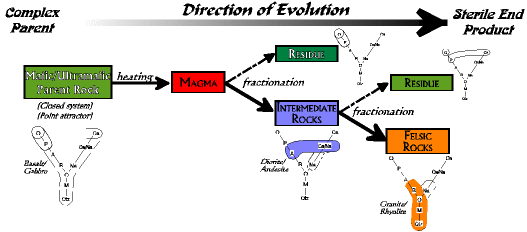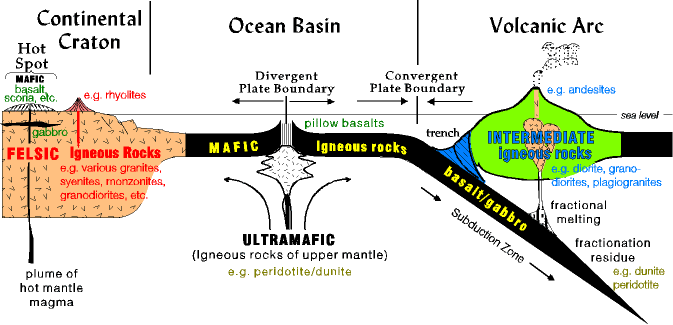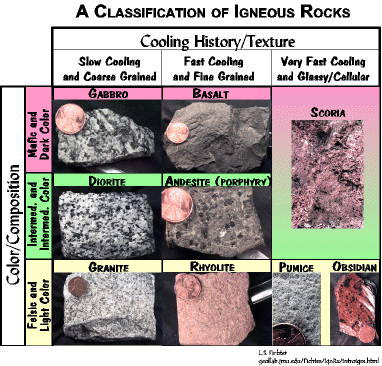 An introduction to igneous rocks requires exploration of three core ideas. Each of these is introduced simplistically below, and then further explored in other pages of the site. FORMATION, CLASSIFICTION AND IDENTIFICATION
The inside of the earth is very hot - hot enough to melt rocks. And the deeper you go the hotter it gets. Below the surface the molten rock is called magma; at the earth's surface it becomes lava, although nothing has changed except the name.The fresh magma is white hot, brillant enough that you would have trouble looking at it. But as it cools it turns yellow, and then various shades of red. Eventually it cools enough to solidify completely and form an igneous rock, such as the granite and basalt below. Granite and basalt are the two most abundant igneous rocks at the earth's surface.
Magma/lava is a mixture of elements such as silica, iron, sodium, potassium, etc. As the magma/lava cools these elements chemically combine, or crystallize, in geometric patterns to form the eight rock forming minerals. For example, in the granite above the pink is orthoclase, the black biotite, and clear to gray mostly quartz (see enlargement). These eight minerals form the bulk of igneous rocks. They are arranged in Bowen's Reaction Series (BRS) by temperature of formation, high temperature ones at the top and low temperature ones at the bottom. Although it is useful to know these minerals they are not essential for a basic understanding of igneous rocks.
Magma/lava also contains lots of gasses such as water, sulfur dioxide, carbon dioxide, etc., and these are driven off into the atmosphere during cooling. (See Table to right of gasses from the Hawaiian volcano.) These are "coarse grained" (or phaneritic). Any rock in which the grains can be seen by eye are coarse grained. If cooling is "very quick" (hours to days) the elements and compounds are frozen in place, no minerals form, and the result is a glass. For example the scoria to above left and the obsidian above right. Basalt and granite are two of the most common igneous rocks found at the earth's surface. They illustrate the diversity of properties igneous rocks have.
Igneous rocks are classified in several different ways (link), but all rock classifications are a combination of texture and color/composition of the rock. The variety of igneous textures is in the table below
The color/composition of the rock is at its simplest divided into dark colored rocks (mafic), intermediate colored rocks (intermediate), and light colored rocks (felsic). If we combine texture/cooling history and color/composition in a grid we get the classification in the table below. A pdf version of this classification table will print as good as the original.
There are two ideas about igneous rocks that are geologically important. The first idea is that igneous rocks evolve - they change from one kind of rock into another. The second idea is that rocks are not randomly distributed across the earth. Specific kinds of rocks are always found in specific places for specific reasons, all tied into plate tectonic processes. These ideas of igneous rock evolution and distribution are related, and eventually we will explore their relationships. For now, we just introduce the basic ideas. IGNEOUS ROCK EVOLUTION
One of the most important ideas geology has discovered is that igneous rocks evolve. That the earth began with a composition similar to that of the moon, that is, composed mostly of an mafic/ultramafic parent rock, and from that simple beginning all the other rocks have evolved through a sequence of fractionation processes. It is a core concept essential to understanding the Earth's evolution that is explored in the Wilson Cycle and a Plate Tectonic Rock Cycle. During fractional melting, for example the mafic parent rock selectively melts producing two fractions. The first fraction is a melt whose composition is closer to the bottom of Bowen's Reaction Series than the original rock. This melt is intermediate in composition. The second fraction is the unmelted crystal residue with a composition more mafic than the original rock. That is, its composition is higher in BRS than the original rock. If time and conditions allow, the fractionation process can continue and the intermediate rock produced during the first fractionation can fractionate into a felsic magma (granite), leaving behind a crystal residue more mafic than the intermediate rock. The fractionation process continues until everything that can be fractionated out of the original composition has been removed. The process is then at an end. PLATE TECTONICS, AND IGNEOUS ROCK DISTRIBUTION  Igneous rock evolution does not just happen anywhere. It takes special plate tectonic conditions. A basic understanding of plate tectonics is necessary here, and if you are unfamiliar with the ideas go to this link for a quick, simple introduction.
Igneous rock evolution does not just happen anywhere. It takes special plate tectonic conditions. A basic understanding of plate tectonics is necessary here, and if you are unfamiliar with the ideas go to this link for a quick, simple introduction. In terms of earth processes, fractionation occurs at two main locations, divergent plate boundaries, and convergent plate boundaries. Divergent plate boundaries (drawing or definition) are mostly under water so we do not easily see them working. But here magma rises up from deep in the earth and oozes out onto the ocean floor to form new oceanic lithosphere (simple drawing; or a more detailed drawing). In the process the parent rock of the earth's interior fractionates to form mafic igneous rocks, e.g. basalt and, at depth, gabbro. At convergent plate boundaries (drawing or definition) part of the ocean lithosphere (created at divergent plate boundaries) descends into the earth again, where it heats up and fractionally melts (drawing). This generates intermediate rocks at first, such as diorite, but may eventually create felsic rocks such as granite. On an earth time scale, igneous fractionation is responsible for the formation of all the world's volcanic arcs and continents, the implication being, the earth began without continents, and the total size of the continents has grown with geologic time. Contemplate the earth with no continents. It is easy to appreciate the importance of igneous fractionation to just about everything about the earth. A final outcome of all this is that different igneous rocks are found in different places on the earth, and all these different distributions are related to plate tectonic processes, and to the history of the earth. At its simplest, continents are made of felsic igneous rocks (such as granite), ocean basins made of mafic igneous rocks (such as basalt and gabbro), and volcanic arcs of intermediate igneous rocks (such as diorite and andesite.) Go On To: |
